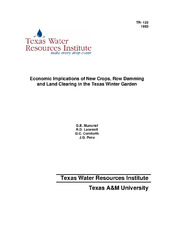| dc.description.abstract | The chief sources of groundwater for the Texas Winter Garden are the Carrizo (Dimmit, Zavala, Frio, and LaSalle Counties) and Edwards (Uvalde County) Aquifers. The major user of groundwater in the region is irrigation. However, insufficient aquifer recharge relative to groundwater use has stimulated interest in alternatives to ease adjustments to diminished groundwater supplies.
The impact on net revenue, groundwater utilization, and land use of new crops (guar, guayule, and short-season irrigated cotton), row damming, and conversion of range to cropland was evaluated using a regional linear programming model. Temporal analysis, 1981-2001, incorporated changes in groundwater availability, static groundwater levels, and corresponding fixed and variable costs.
Introduction of guar and short-season irrigated cotton (base solution) was associated with increased groundwater pumpage from the Carrizo Aquifer, increased net revenue, and increased irrigated acreages. Edwards Aquifer pumpage remained constant at an upper limit. When guayule entered the base solution, net revenue rose by four million dollars and groundwater pumpage and irrigated acreages declined only in the Carrizo Aquifer.
Land clearing without guayule added 17, 25.2, and 26.3 million dollars to net revenue for light; light and medium; and light, medium, and heavy brush clearing; respectively. Under light brush clearing about 480,000 acres were added to cropland and groundwater pumpage remained steady. Pumpage increased under the other land clearing activities. Land clearing with guayule almost doubled net revenue compared to land clearing without guayule.
Row damming was the most effective alternative in reducing dependence on groundwater. Row damming in dryland grain sorghum and dryland cotton decreased groundwater pumpage and increased net returns above the base by 6.7 million dollars without land clearing and 18.6, 30.3, and 32.9 million dollars with the respective land clearing alternatives. Carrizo Aquifer groundwater pumpage was significantly reduced in each of the four alternatives and Edwards pumpage was reduced in all but the heavy brush clearing alternative.
Under temporal and static analysis for projected (forecast) groundwater pumpage, net revenue, groundwater pumpage, and irrigated acres exceeded those of solutions with restricted (forced conservation) groundwater. Carrizo Aquifer groundwater pumpage was greater under restricted than in the projected groundwater scenarios. | en |


